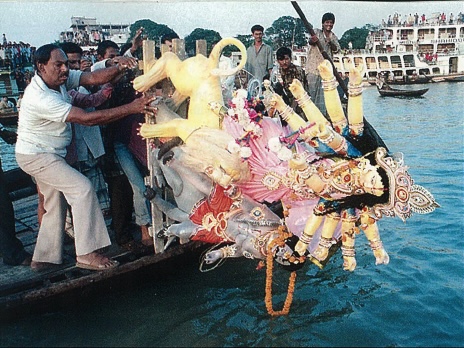The Hindus of Bangladesh are worshippers of Durga Devi, a form of Shakti, the all-powerful Goddess in all Her glory. Like their kin in nearby West Bengal, the ten-day Durga Puja in September/October is the most vital festival for Hindus. This same festival for the Goddess is celebrated as Dussehra and Navaratri elsewhere in India. Elaborate decorations and Sanskrit shlokas invoke the Mother Goddess to bless all the devotees who come to see Her.
The annual pomp and pageantry suffered a devastating blow in 1990, when all across Bangladesh pandals (elaborate temporary temples set up along the roadsides) and images were rampaged and looted. More than fifty pandals in Dhaka were mercilessly destroyed at the hands of Muslim fanatics. The once joyous season was overshadowed by a cloud of fear over the lack of protection and the violent shaking of devotee’s faith.
Ignored by the police, outnumbered by the Muslims, Hindus in 1992 for the first time in Bangladesh and Hindu history, performed Durga Puja without the Deity present in physical form–only a ghot or khumba (a coconut on a pot). In 1996, 20,000 pandals with Deities were set up across the country, a few more than the previous year. That year the Prime Minister Sheikh Hasina told devotees at the Dhakeswari temple in Dhaka, “You will have the equal rights to practice your respective religions with full dignity and honor and none to interfere in it.” But in 1997, the Organiser newspaper from Delhi reported, “Gangs descended on puja pandals and demanded jazia [the Islamic tax on non-Muslims] from the puja organizers for performing ‘idol worship’ in Islamic Bangladesh. Since the pattern of attack was the same throughout Bangladesh, it is suspected that it was a well-planned operation, especially because no police help was available.”
The Durga Puja popular across all of the Bengali-speaking area is an ancient home festival. Rich devotees in the last century turned their home puja into a grand community affair. Soon all the rich families did the same. Today most pandals are erected by community organizations.
The Bangladesh community in New York was able to celebrate Durga Puja in their own, newly acquired, temple for the first time in 1998, and considered this a great landmark. “It is freedom indeed,” said Dwijen Bhattacharjya, “to be able to attend puja wearing dhotis and saris, the women flaunting sindoor and sankha [wedding signs], and to let our children celebrate our tradition without fear!”
